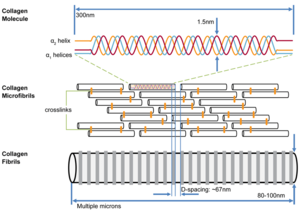Fibrous Connective Tissues: Difference between revisions
(Created page with "{{stub}} It could be said that Musculoskeletal Medicine is the study of disorders of fibrous connective tissues. Fibrous connective tissues are those tissues that are designed...") |
No edit summary |
||
| Line 11: | Line 11: | ||
These various components are synthesised by cells. Fibroblasts manufacture the components of tensile tissues. Chondroblasts produce the components of cartilage. Osteoblasts form the components of bone. These various cells can transform into one another for example ligaments can become cartilaginous and then osseous. | These various components are synthesised by cells. Fibroblasts manufacture the components of tensile tissues. Chondroblasts produce the components of cartilage. Osteoblasts form the components of bone. These various cells can transform into one another for example ligaments can become cartilaginous and then osseous. | ||
== | ==Collagen== | ||
[[File:Tendon hierarchical organisation.jpg|thumb|The hierarchical organisation of tendons]] | |||
[[File:Collagen structure and organisation.png|thumb|The hierarchical organisation of collagen molecules which self-assemble in a quarter-staggered array into microfibrils to form collagen fibrils with characteristic spacing.]] | |||
The primary component of collagen is a polypeptide. The secondary structure is a helix. These helices are arranged into a tertiary structure called a triple helix. Those components are aggregated into a quaternary structures in increasing complexity: microfibrils -> fibrils -> fibres -> bundles -> fascicles | The primary component of collagen is a polypeptide. The secondary structure is a helix. These helices are arranged into a tertiary structure called a triple helix. Those components are aggregated into a quaternary structures in increasing complexity: microfibrils -> fibrils -> fibres -> bundles -> fascicles | ||
The primary chemical structure of collagen is tropocollagen, which consists of three polypeptide chains, each in a helix, all winding around one another, then individual chains spliced end to end. This is at the molecular level. | The primary chemical structure of collagen is tropocollagen, which consists of three polypeptide chains, each in a helix, all winding around one another, then individual chains spliced end to end. This is at the molecular level. The individual chains aren't infinite, they are bonded end-to-end with subsequent chains. | ||
One of the sources of resistance to tension is the end-to-end bonding between the polypeptide chains. Otherwise this triple helical structure when subjected to tension has the spaces between the helices taken up a little without it disrupting as it flattens out. However there is an electrical repulsion resisting this. | |||
The tropocollagens are staggered in an array so that the end-to-end bonding aren't all lined up. Side to side the chains are bounded by covalent bonds. With ageing, cross-linking occurs, which increases the stiffness and resistance to stretch. | |||
[[Category:Anatomy]] | [[Category:Anatomy]] | ||
Revision as of 13:47, 11 August 2021
It could be said that Musculoskeletal Medicine is the study of disorders of fibrous connective tissues. Fibrous connective tissues are those tissues that are designed to withstand mechanical deformation.
Structural Overview
Deformation comes in two principal forms, tension and compression. However there are also shear forces. To withstand tension the body forms "strings" in the form of collagens. To withstand compression the body develops a fluid "mush" in the form of proteoglycans.
The fibrous connective tissues exist in a spectrum of composition. The more a tissue is required to withstand tension the more collagen it will have, while the more it is required to withstand compression the more proteoglycans it will have.
Tendons (principally collagen) -> ligaments (principally collagen plus 0.5% proteoglycans) -> fascia (mixed collagen and proteoglycans) -> cartilage (principally proteoglycans plus some collagen) -> bone (essentially cartilage that has been doped by calcium)
These various components are synthesised by cells. Fibroblasts manufacture the components of tensile tissues. Chondroblasts produce the components of cartilage. Osteoblasts form the components of bone. These various cells can transform into one another for example ligaments can become cartilaginous and then osseous.
Collagen
The primary component of collagen is a polypeptide. The secondary structure is a helix. These helices are arranged into a tertiary structure called a triple helix. Those components are aggregated into a quaternary structures in increasing complexity: microfibrils -> fibrils -> fibres -> bundles -> fascicles
The primary chemical structure of collagen is tropocollagen, which consists of three polypeptide chains, each in a helix, all winding around one another, then individual chains spliced end to end. This is at the molecular level. The individual chains aren't infinite, they are bonded end-to-end with subsequent chains.
One of the sources of resistance to tension is the end-to-end bonding between the polypeptide chains. Otherwise this triple helical structure when subjected to tension has the spaces between the helices taken up a little without it disrupting as it flattens out. However there is an electrical repulsion resisting this.
The tropocollagens are staggered in an array so that the end-to-end bonding aren't all lined up. Side to side the chains are bounded by covalent bonds. With ageing, cross-linking occurs, which increases the stiffness and resistance to stretch.


